I have been into edible gardening in my backyard for over a decade now. I have seen several worms wiggling around my crops and even munching the foliages. But through research, I discovered that these black and yellow caterpillars are the larval stage of butterflies or moths.
I wrote this article guide to help you identify the yellow and black caterpillars in your backyard garden. Different caterpillar type identification relies on certain characteristics, and it can be challenging to take them apart.
All insects have scientific names and common names. Black and yellow fuzzy caterpillars also have scientific names and common names. Take the time to read my yellow and black caterpillar identification chart guide for more insights.
You May Also Like: Types of Butterfly Caterpillars with Pictures
How to Identify Black and Yellow Caterpillars
A yellow and black fuzzy caterpillar has six legs, distinctive markings, stumpy-looking legs, and a tuft of hairs or spines. These grubs also have different lengths and eat specific plants.
All types of caterpillars go through several changes before entering the pupa stage. Newly hatched caterpillar from pupa tends to look different from the adult butterfly or moth.
Yellow and black caterpillars are worm-like, crawling creatures and leaf-eating grubs belonging to order Lepidoptera. A yellow caterpillar with black stripes measures 1- 6 inches.
Black caterpillars with yellow stripes are common in North America and Europe. My caterpillar identification chart guide highlights the scientific name, features, and habitats.
Different Types of Black and Yellow Caterpillars
Fuzzy yellow and black caterpillars are stunning and fascination. Below is a list of yellow and black caterpillars with stripes, fuzzy, hairs, and smooth bodies:
Monarch Caterpillar (Danaus plexippus)
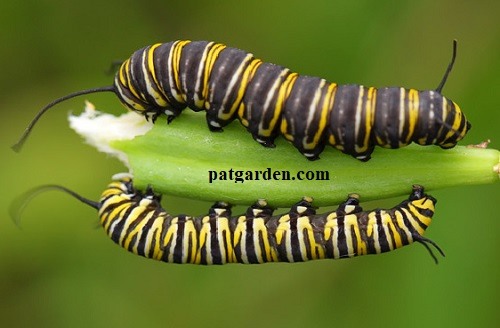
A monarch caterpillar has a distinctive yellow, white, and black stripe with long and fat bodies marked with white prolegs and two black tentacles.
The yellow and black monarch caterpillar can reach 1- 1.7 inches long. They feed on milkweed plants, and the diet makes these grubs among a few poisonous black and yellow caterpillars.
These caterpillar species are native to Northern America and Southern Canada. The larva goes through several instars before turning into the pupa stage.
White-Marked Tussock Furry Horned Caterpillar (Orgyia leucostigma)
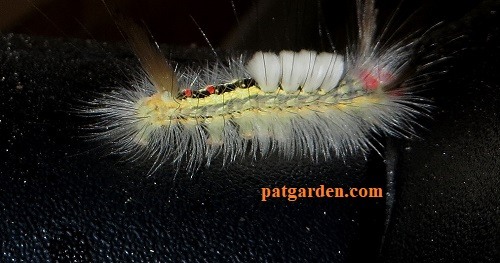
A white-marked tussock furry horned caterpillar has a black body with yellow stripes and a redhead. The yellowish-white stinging hairs can cause allergic reactions to humans.
The fuzzy black and yellow caterpillar can reach 1.3 inches long. These grubs are prevalent during the summer in the East and North America.
Yellow Spotted Tussock Moth Caterpillar (Lophocampa maculata)
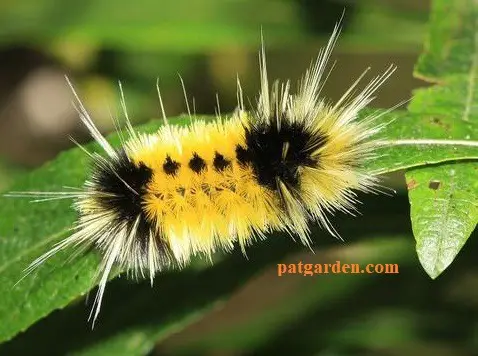
A yellow-spotted tussock moth caterpillar has distinctive black and yellow fuzzy bands with a tuft of white hairs. The grub tends to look like a giant bumblebee.
The spines on the caterpillar can give a nasty sting if handled without protective gloves. But these spiny hairs are not poisonous.
These large black and yellow caterpillars are native to Canada and the Western parts of the United States. They feed on oak, willow, alder, and maple leaves.
Six-Spot Burnet Caterpillar (Zygaena filipendulae)
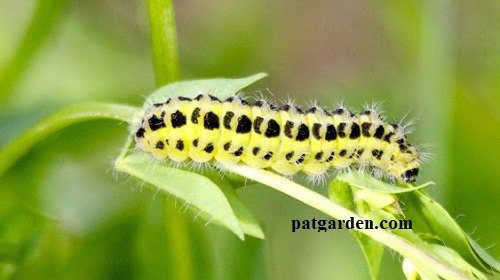
A six-spot burnet caterpillar has horizontal black line patterns on a pale and translucent yellow body. The caterpillar can reach 2cm long at maturity.
These yellow and black caterpillars are rare and hail from the United Kingdom. These black and yellow fuzzy caterpillars turn into black moths that fly in the daytime.
Queen Caterpillar (Danaus gilippus)
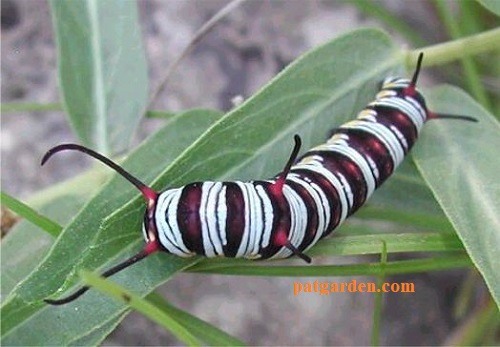
A queen caterpillar has a black body with white transverse bands and two large yellow dots on each segment. The six black fleshy tentacles make the grub resembles its monarch counterpart.
The grub also has a smooth body with a black head and white rings. This black, white, and yellow striped caterpillar turns into a stunning red butterfly.
Catalpa Sphinx (Ceratomia catalpae)
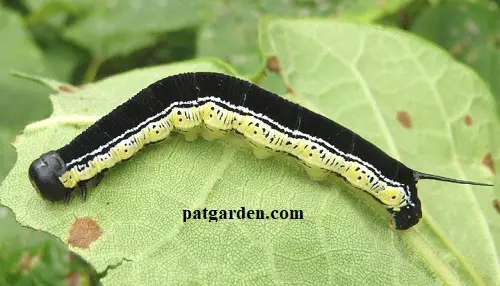
A catalpa sphinx has a jet black body with yellow and black markings along its sides. Immature larvas have light colors with few markings.
This black and yellow fuzzy caterpillar is known Catawba worm and can reach 5cm long. These grubs have a black head and tapered tail end.
Catalpa sphinx caterpillars are native to cigar trees in Maine, Texas, Florida, and Lowa. These worm-like black and yellow caterpillars turn into large brown catalpa sphinx moths.
Giant Sphinx Caterpillar (Pseudosphinx tetrio)
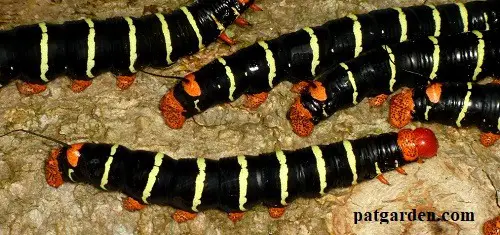
A giant sphinx caterpillar has a jet black body with distinctive yellow bands. The orange tail, head, and prolegs make this grub stand out.
The grub can reach six inches long, and it is poisonous to small animals or birds. The barbed and stinging hairs are its defense mechanism.
Black and Yellow Zebra Caterpillar (Melanchra picta)
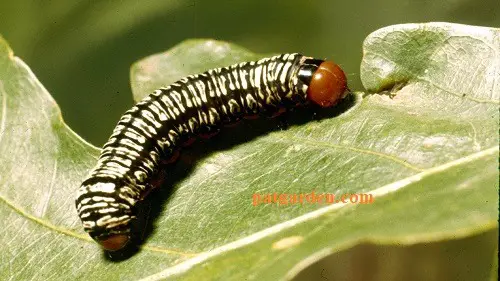
A zebra caterpillar has broad creamy-yellow stripes and thinner black stripes. The zebra-like patterns with reddish-brown undersides make the grub stand out.
The black and yellow striped caterpillar can reach 3-4cm long. These grubs feed in small compact groups until molting, and they are native to the United States of America.
Common Sheep Moth Caterpillar (Hemileuca eglanterina)
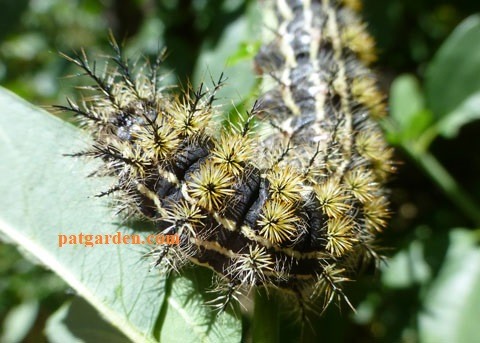
A common sheep moth caterpillar has yellowish or orange tufts on its back. This menace-looking caterpillar also has a brownish-black body and tufts of black spikes with yellow spines.
The yellow and black caterpillar loves feeding on foliages of bitter cherry, bitterbrush, wild roses, and mountain lilac. A mature caterpillar turns into a striking orange or pink moth.
Yellow and Black Cinnabar Caterpillar (Tyria jacobaeae)
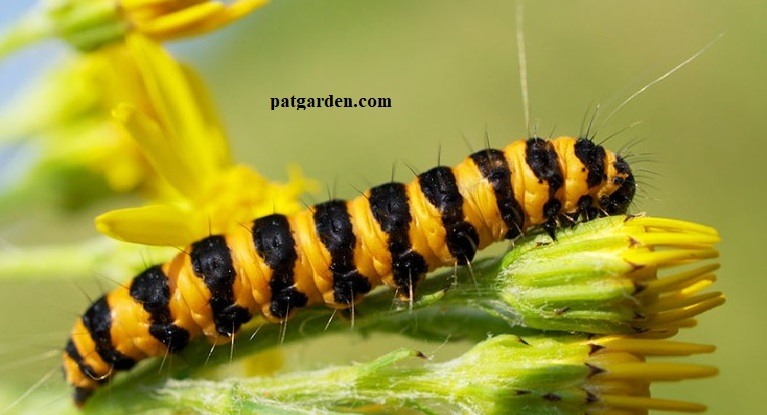
A cinnabar caterpillar is a jet black and yellow caterpillar with thin hair-like black or yellow spines. It can reach 3cm long and hails from Europe and Asia.
Cinnabar caterpillars love eating ragwort which makes their spines poisonous. A mature grub can transform into a spectacular black and red moth.
Brown-Hooded Owlet (Cucullia convexipennis)
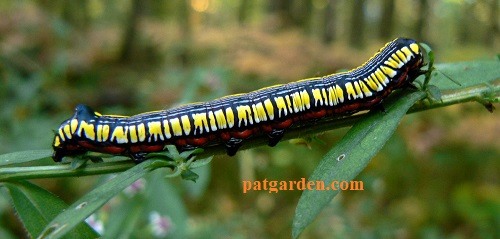
A brown-hooded owlet caterpillar is a small black grub with yellow and white markings in a wide horizontal band along the body. The yellow and black fuzzy caterpillar can reach an inch long.
This small black and yellow caterpillar is also called a calico paint caterpillar. The shiny black head and yellow markings make this grub stand out.
Brown-hooded Owlet caterpillars are native to the United States of America and parts adjacent to Canada. The larvae feed on solidago, aster, and Callistephus chinensis.
Black Swallowtail Caterpillar (Papilio polyxenes)
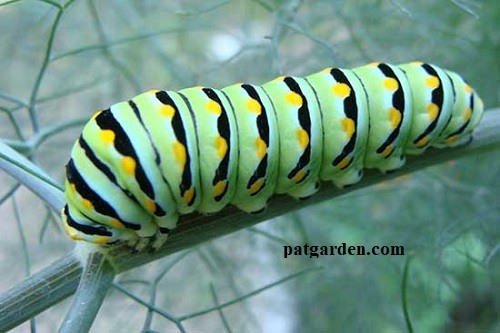
A swallowtail caterpillar has black bands and yellow dots on a bright green body. This green caterpillar has white or green prolegs with black and yellow markings.
The grub tends to change its appearance as it grows. A juvenile larva has a white band around the middle section. Black swallowtail caterpillars are native to North America.
Yellownecked Caterpillar (Datana ministra)
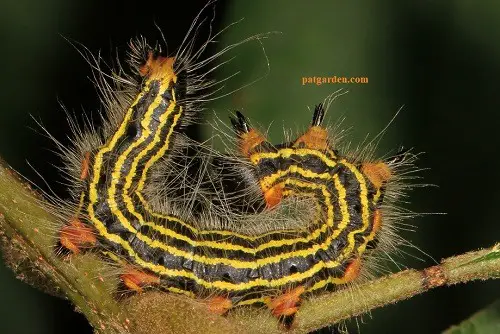
A yellow-necked caterpillar has a black hairy body with longitudinal yellow stripes. The yellow and black feet are other distinctive features.
The yellow-necked grub tends to curl its body into a U-shaped when felt threatened. The caterpillars are common in Southern Canada and the Eastern United States of America.
Mullein Moth Caterpillar (Cucullia verbasci)
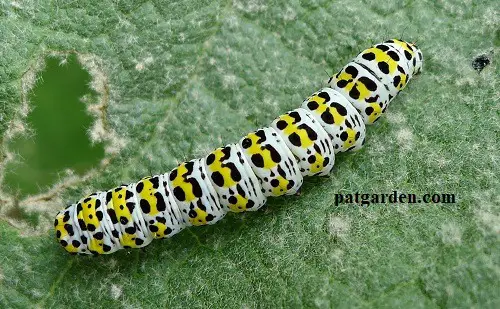
A mullein moth caterpillar has black and yellow markings on its white or pale grayish body. It can reach 5cm long.
The grubs feed on buddleia plant leaves during the July and August climate. These caterpillars can defoliate bushes in Denmark and Estonia.
Grapeleaf Skeletonizer (Harrisina americana)
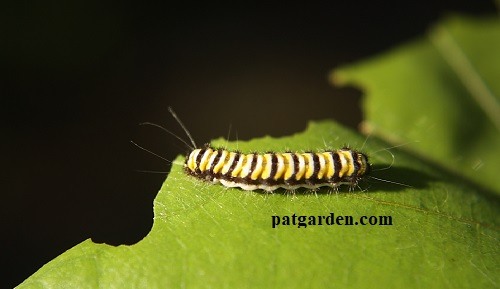
A grape leaf skeletonizer is a yellow caterpillar with bands of black dots. These grubs love munching leaves of grapevine plants.
These caterpillars feed on a line on the leaves. The spiny hairs can irritate the skin and result in nasty rashes. These grubs are common in the Eastern United States of America.
Redhumped Caterpillar (Schizura concinna)
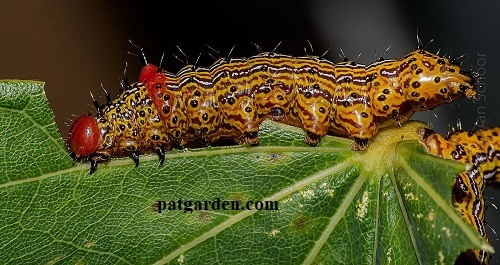
A red-humped caterpillar has a redhead, short black fleshy tentacles, and red humps with yellow and black stripes. This striped caterpillar has black and white horizontal bands and black lines.
These grubs feed in groups on walnut trees, willow trees, fruit trees, and cottonwood. These caterpillar species are native to Canada and America.
American Dagger Caterpillar (Acronicta americana)
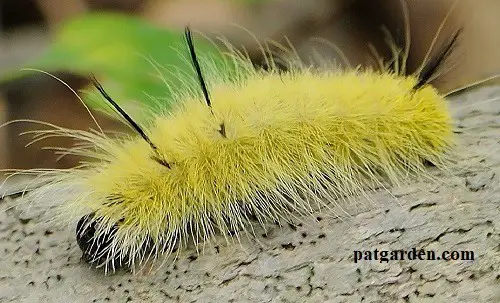
An American dagger caterpillar has long and fine feather hairs covering the body. These hairs can cause skin irritation after handling.
These caterpillars can reach 5cm long each, with a glossy blackhead. These grubs also have two pairs of long black hair-like spines on their back and one at the tail.
These furry yellow caterpillars love hickory, birch, oak, maple, and poplar trees. The pupa turns into a spectacular brown moth.
Smeared Dagger Moth Caterpillar (Acronicta oblinita)
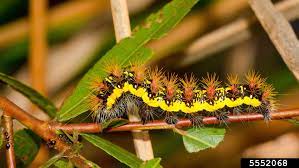
A smeared dagger moth caterpillar has a bristly black body with yellow longitudinal bands and white markings on its back.
The jaggy-looking tufts of white or reddish-brown spines are for defense mechanism. These spines give a nasty sting when handled. These grubs hail from North America and Britain.
Fall Webworm (Hyphantria cunea)
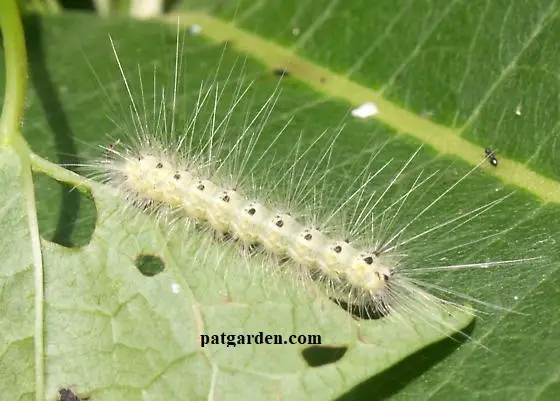
A fall webworm has a yellow bristly body with black dots and long yellow spines. The web nets hanging from the tips of hardwood trees in late summer and fall help to identify the grubs.
These small fuzzy caterpillars can be pale yellow with black dots or dark green with light markings. Each segment has black dots with a tuft of white or yellow bristles.
These yellow and black caterpillars munch leaves on walnut, cherry, crabapple, and other deciduous trees. Fall webworms hail from Europe and Asia.
White Flannel Moth Caterpillar (Norape ovina)
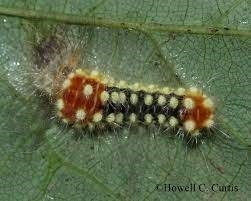
A white flannel moth caterpillar has a black body with yellow spots and tufts of stinging spines. These grubs have yellow undersides and yellow feet.
These tufts of stinging spines can cause skin irritations. I recommend not touching the caterpillar without protective gloves. The yellow-spotted caterpillar turns into a striking white hairy moth.
Frequently Asked Questions
What Do Black and Yellow Caterpillars Eat?
These grubs love lamb quarters, violets, and clovers. They also munch leaves of sunflower, burdock, nettles, spinach, cabbages, asters, and dandelions.
Are Black and Yellow Caterpillars Poisonous?
No. Black and yellow fuzzy caterpillars are harmless to humans or animals. But the stinging spines can cause skin irritation.
Are Black Swallowtail Caterpillars Poisonous?
Yes. These grubs consume leaves from ragwort plants and store the juice in form of aristolochic acid. The sequester poisonous is harmful to small rodents and birds.
What Kind of Butterfly Comes from a Black and Yellow Caterpillar?
A monarch caterpillar has a black and yellow body with white stripes. The caterpillar species turn into a spectacular yellow and black butterfly.
Final Word
Identifying a black and yellow fuzzy caterpillar can be a challenging and intimidating experience for beginners. I hope this black caterpillar identification chart was helpful.
Feel free to share this yellow and black caterpillar identification chart guide with your friends or families in any community. Remember to share your experience with all types of caterpillars.
You May Also Like: